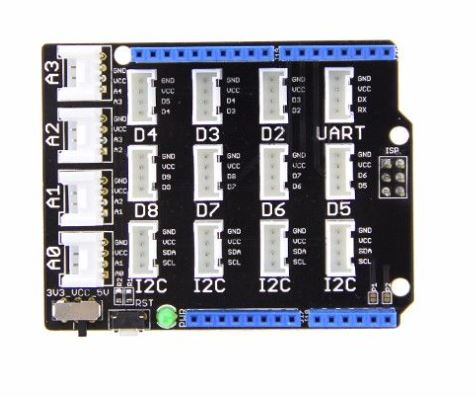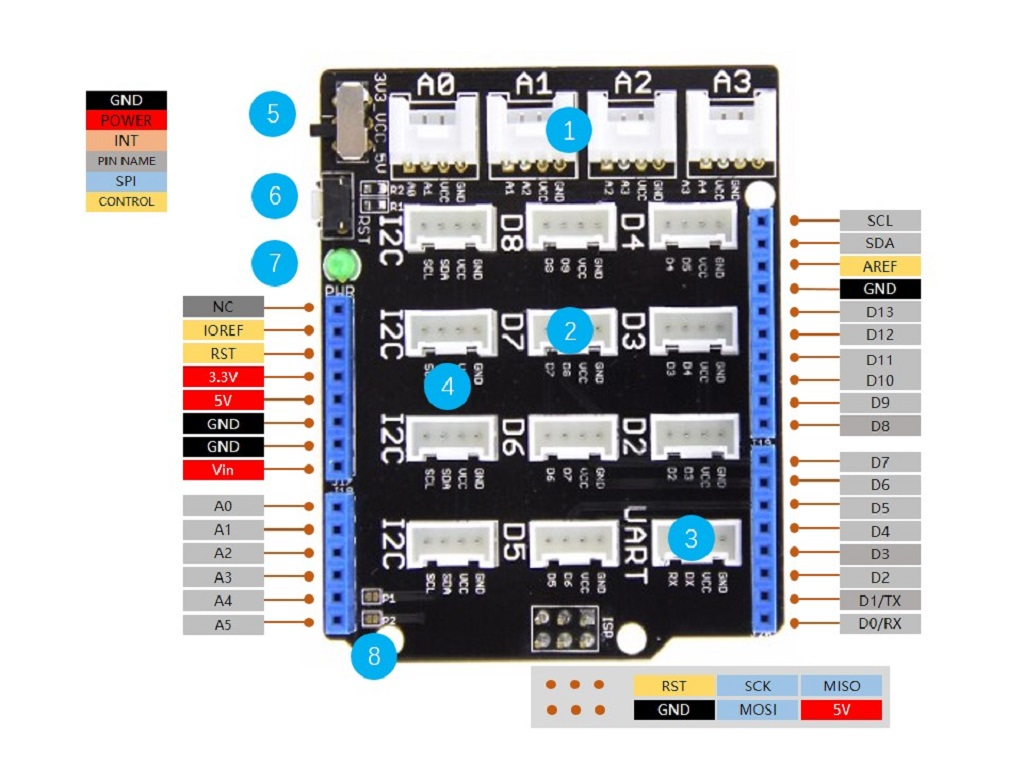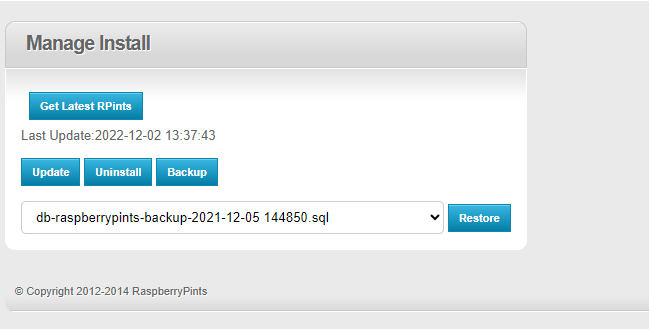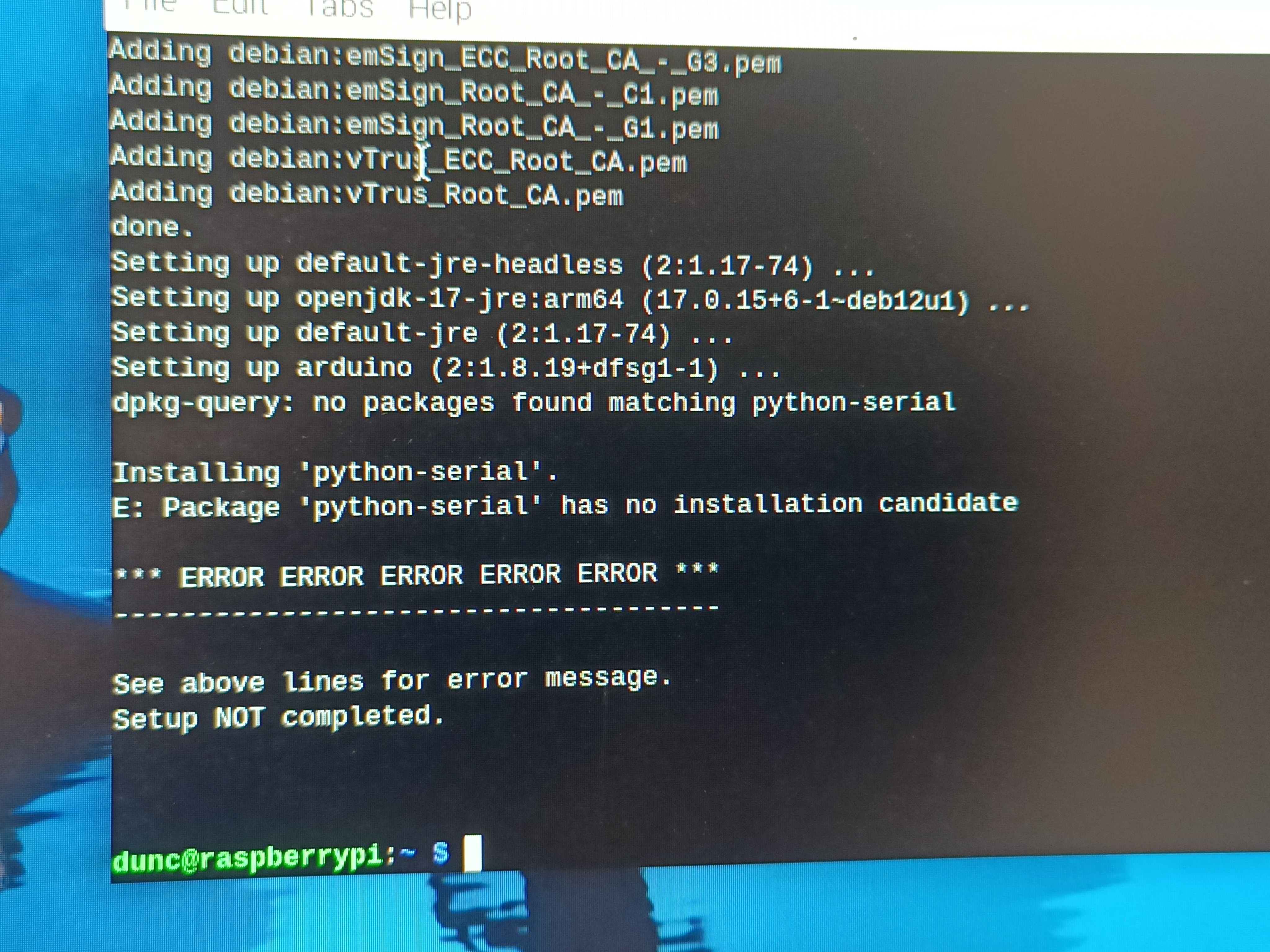Great!cache and that worked Thanks!
You are using an out of date browser. It may not display this or other websites correctly.
You should upgrade or use an alternative browser.
You should upgrade or use an alternative browser.
[Version 2 Release] RaspberryPints - Digital Taplist Solution
- Thread starter skemp45
- Start date

Help Support Homebrew Talk:
This site may earn a commission from merchant affiliate
links, including eBay, Amazon, and others.
DuncB
Well-Known Member
I have one of these
https://www.seeedstudio.com/Base-Shield-V2.html
it has the same pinouts as arduino uno.
I have connected this and had it working with one flowmeter ( 3 wire ) via digital connector D7. I did this ages ago and can't remember why I didn't start with D2.
I now have the rest of my flowmeters and want to connect up to ten of them, initially just aiming for 7, this is more than the number of D connectors.
Currently I have VCC, Gnd and a digital pin going to the meter, it works accurately after calibration.
Can anyone offer some advice as to whether I just continue this process connecting each meter to a D connector the same way?
I think I can do this but I am not sure how to decide the pin designation of each of these D connectors to input into raspberry pints for each of the flow meters on the setup page.
Thanks for any advice.
https://www.seeedstudio.com/Base-Shield-V2.html
it has the same pinouts as arduino uno.
I have connected this and had it working with one flowmeter ( 3 wire ) via digital connector D7. I did this ages ago and can't remember why I didn't start with D2.
I now have the rest of my flowmeters and want to connect up to ten of them, initially just aiming for 7, this is more than the number of D connectors.
Currently I have VCC, Gnd and a digital pin going to the meter, it works accurately after calibration.
Can anyone offer some advice as to whether I just continue this process connecting each meter to a D connector the same way?
I think I can do this but I am not sure how to decide the pin designation of each of these D connectors to input into raspberry pints for each of the flow meters on the setup page.
Thanks for any advice.
The original kit recommended using an "Alamode" shield atop the RaspberryPi for a compact package, but the Alamode has extra functionality over an UNO with things like an RTC - which uses some of the lower GPIOs. I found D2 and D5 through D12 could be used without conflicts. D0 and D1 are for the UART, of course, and D3 and D4 were used by the RTC, and finally D13 is shared with the "Blink" LED.
Using an UNO D3 and D4 are usable/not shared. So you should be able to use at least D2 through D12 without conflicts, but you'll have to grab D10 through D12 from the standard headers as there aren't Grove headers for those on your shield...
Cheers!
Using an UNO D3 and D4 are usable/not shared. So you should be able to use at least D2 through D12 without conflicts, but you'll have to grab D10 through D12 from the standard headers as there aren't Grove headers for those on your shield...
Cheers!
DuncB
Well-Known Member
Thank you,The original kit recommended using an "Alamode" shield atop the RaspberryPi for a compact package, but the Alamode has extra functionality over an UNO with things like an RTC - which uses some of the lower GPIOs. I found D2 and D5 through D12 could be used without conflicts. D0 and D1 are for the UART, of course, and D3 and D4 were used by the RTC, and finally D13 is shared with the "Blink" LED.
Using an UNO D3 and D4 are usable/not shared. So you should be able to use at least D2 through D12 without conflicts, but you'll have to grab D10 through D12 from the standard headers as there aren't Grove headers for those on your shield...
Cheers!
When you say grab from the standard header, do you mean the pins on the raspberry pi?
Or the board that the shield connects to?
The board only has D2 to D8 so do I grab D9 To D12 from the standard headers or are some of the I2C connections usable?
Also how do I know what pin to assign for each of the D connections on the flowmeter setup?
Thanks again

Last edited:
I meant from the single row gpio headers - on the the shield.
The Grove headers with I2C are all connected to the UNO's SCL and SDA pins so they're not going to be useful for your flow meters. Nor are the Grove headers for the analog pins A0 through A5.

The relationship between your UNO signals (D2 through D12) and RaspberryPints is set up inside RaspberryPints in a table. I am 200 miles from home so can't point you to the specific configuration page but it's in there somewhere I'll be home in a couple of days otherwise...
I'll be home in a couple of days otherwise...
Cheers!
The Grove headers with I2C are all connected to the UNO's SCL and SDA pins so they're not going to be useful for your flow meters. Nor are the Grove headers for the analog pins A0 through A5.

The relationship between your UNO signals (D2 through D12) and RaspberryPints is set up inside RaspberryPints in a table. I am 200 miles from home so can't point you to the specific configuration page but it's in there somewhere
Cheers!
DuncB
Well-Known Member
ThanksI meant from the single row gpio headers - on the the shield.
The Grove headers with I2C are all connected to the UNO's SCL and SDA pins so they're not going to be useful for your flow meters. Nor are the Grove headers for the analog pins A0 through A5.
View attachment 858470
The relationship between your UNO signals (D2 through D12) and RaspberryPints is set up inside RaspberryPints in a table. I am 200 miles from home so can't point you to the specific configuration page but it's in there somewhereI'll be home in a couple of days otherwise...
Cheers!
Hope the travel is good.
I know the table, it's selected from the beers page I think where you configure the flowmeters you also select the pin associated with the meters.
I'll have a play around by attaching two meters and see what put number I need to use to get it working, should be logical ( I hope).
I'll update.

$719.00
$799.00
EdgeStar KC2000TWIN Full Size Dual Tap Kegerator & Draft Beer Dispenser - Black
Amazon.com

$20.94
$29.99
The Brew Your Own Big Book of Clone Recipes: Featuring 300 Homebrew Recipes from Your Favorite Breweries
Amazon.com

$176.97
1pc Commercial Keg Manifold 2" Tri Clamp,Ball Lock Tapping Head,Pressure Gauge/Adjustable PRV for Kegging,Fermentation Control
hanhanbaihuoxiaoshoudian

$53.24
1pc Hose Barb/MFL 1.5" Tri Clamp to Ball Lock Post Liquid Gas Homebrew Kegging Fermentation Parts Brewer Hardware SUS304(Liquid Hose Barb)
yunchengshiyanhuqucuichendianzishangwuyouxiangongsi

$22.00 ($623.23 / Ounce)
AMZLMPKNTW Ball Lock Sample Faucet 30cm Reinforced Silicone Hose Secondary Fermentation Homebrew Kegging joyful
无为中南商贸有限公司

$76.92 ($2,179.04 / Ounce)
Brewing accessories 1.5" Tri Clamp to Ball Lock Post Liquid Gas Homebrew Kegging Fermentation Parts Brewer Hardware SUS304 Brewing accessories(Gas Hose Barb)
chuhanhandianzishangwu

$58.16
HUIZHUGS Brewing Equipment Keg Ball Lock Faucet 30cm Reinforced Silicone Hose Secondary Fermentation Homebrew Kegging Brewing Equipment
xiangshuizhenzhanglingfengshop

$28.98
Five Star - 6022b_ - Star San - 32 Ounce - High Foaming Sanitizer
Great Fermentations of Indiana

$7.79 ($7.79 / Count)
Craft A Brew - LalBrew Voss™ - Kveik Ale Yeast - For Craft Lagers - Ingredients for Home Brewing - Beer Making Supplies - (1 Pack)
Craft a Brew

$53.24
1pc Hose Barb/MFL 1.5" Tri Clamp to Ball Lock Post Liquid Gas Homebrew Kegging Fermentation Parts Brewer Hardware SUS304(Liquid Hose Barb)
Guangshui Weilu You Trading Co., Ltd

$10.99 ($31.16 / Ounce)
Hornindal Kveik Yeast for Homebrewing - Mead, Cider, Wine, Beer - 10g Packet - Saccharomyces Cerevisiae - Sold by Shadowhive.com
Shadowhive

$479.00
$559.00
EdgeStar KC1000SS Craft Brew Kegerator for 1/6 Barrel and Cornelius Kegs
Amazon.com

$33.99 ($17.00 / Count)
$41.99 ($21.00 / Count)
2 Pack 1 Gallon Large Fermentation Jars with 3 Airlocks and 2 SCREW Lids(100% Airtight Heavy Duty Lid w Silicone) - Wide Mouth Glass Jars w Scale Mark - Pickle Jars for Sauerkraut, Sourdough Starter
Qianfenie Direct

$44.99
$49.95
Craft A Brew - Mead Making Kit – Reusable Make Your Own Mead Kit – Yields 1 Gallon of Mead
Craft a Brew

$159.50 ($26.58 / Count)
3M High Flow Series System BREW120-MS, 5616001, For Brewed Coffee and Hot Tea, Valve-in-Head Design
Amazon.com
You will enter the actual GPIO numbers, 2 through 12. Should be easy, add a meter and blow through it to verify...
Cheers!
Cheers!
DuncB
Well-Known Member
Found it, The taps page, enable pin display at the top via check box, then assign pin ( ie D3 connection) to a tap.
DuncB
Well-Known Member
That is working well in my test setup.
When I start to use the pins 9, 10,11,12 and possibly 13 as I can see this on the board as well.
The pin is for data I think so I can just use another header for 5V ( as highlighted on the diagram ) and a ground.
Do I need a separate 5V and ground for each meter or can I split that supply and ground to the remaining flowmeters and their corresponding pin for data?
If possible could I use the VCC and GND from the I2C or analog grove ports, I have connectors that would fit neatly to do this rather than me making spaghetti?
When I start to use the pins 9, 10,11,12 and possibly 13 as I can see this on the board as well.
The pin is for data I think so I can just use another header for 5V ( as highlighted on the diagram ) and a ground.
Do I need a separate 5V and ground for each meter or can I split that supply and ground to the remaining flowmeters and their corresponding pin for data?
If possible could I use the VCC and GND from the I2C or analog grove ports, I have connectors that would fit neatly to do this rather than me making spaghetti?
You can definitely share 5v power (and GND) between multiple meters, they draw very little current...
Cheers!
Cheers!
DuncB
Well-Known Member
Great and okay to steal it off the grove connections to the I2C or analogs?You can definitely share 5v power (and GND) between multiple meters, they draw very little current...
Cheers!
Sure!
I don't follow this project closely, but I still have rpints.com registered and a redirect to a copy of an install script I did for Tobor_8thMan (no longer a member here, apparently?) in my DNS.
If there's consensus on "who's in charge here?" please let me know. I am happy to either transfer the domain, fix the redirect, or do whatever I can to help (provided it's not a ton of work for me, of course). ).
).
@ me on a reply or use the "reply" button on this message and I will see it.
If there's consensus on "who's in charge here?" please let me know. I am happy to either transfer the domain, fix the redirect, or do whatever I can to help (provided it's not a ton of work for me, of course).
@ me on a reply or use the "reply" button on this message and I will see it.
My version is at https://github.com/rtlindne/RaspberryPintsI don't follow this project closely, but I still have rpints.com registered and a redirect to a copy of an install script I did for Tobor_8thMan (no longer a member here, apparently?) in my DNS.
If there's consensus on "who's in charge here?" please let me know. I am happy to either transfer the domain, fix the redirect, or do whatever I can to help (provided it's not a ton of work for me, of course).).
@ me on a reply or use the "reply" button on this message and I will see it.
The install script that is updated to install everything and based on Tobor_8thMan's original is also there, specifically at https://github.com/rtlindne/RaspberryPints/blob/master/util/installRaspberryPints
Its been a few months since I last tried it but im pretty sure i tried it on the latest Pi Desktop version right after it came out.
DuncB
Well-Known Member
I've got mine working well, thanks to everyone, wondering is it compatible with 64bit yet?
If I wanted to transfer onto a raspberry pi 3 dedicated to pints how would I back up and do this.
Not as simple as taking the SD card out of the Pi 4 and putting it in the 3?
Any ideas?
If I wanted to transfer onto a raspberry pi 3 dedicated to pints how would I back up and do this.
Not as simple as taking the SD card out of the Pi 4 and putting it in the 3?
Any ideas?
I dont know why RPints wouldn't work on 64bit. Nothing is specific to the memory addressing. Maybe some dependency name are different and the installer wont find them.I've got mine working well, thanks to everyone, wondering is it compatible with 64bit yet?
If I wanted to transfer onto a raspberry pi 3 dedicated to pints how would I back up and do this.
Not as simple as taking the SD card out of the Pi 4 and putting it in the 3?
Any ideas?
it does look the Pi OS 64 bit is compatible on the PI 3B so it could be simply move the SD card. I would take a backup of it and then move the backup SD card to the 3d to see if it works instead of your primary SD card.
RPints does have a backup option on the install page, you could do a fresh install on a new PI, use that option on the old PI, then copy the file from <WWWROOT>\html\sql\backups to the new PI, use the same install page on the new PI but with the restore option (make sure to select the correct file if you have multiple files)

DuncB
Well-Known Member
Thank you @RandR+ I will back up and clone for safety.
way back at post #8017
https://www.homebrewtalk.com/thread...digital-taplist-solution.487694/post-10301763
I couldn't get the pints working until I installed the 32bit OS.
Has there been a big update to get pints working with 64 bit bullseye? or a later version?
way back at post #8017
https://www.homebrewtalk.com/thread...digital-taplist-solution.487694/post-10301763
I couldn't get the pints working until I installed the 32bit OS.
Has there been a big update to get pints working with 64 bit bullseye? or a later version?
PI OS is now up to Linux version 12 (bookworm), There are newer versions of the Arduino IDE then those from Bullseye, I didnt find anything specific about uploading to 32bit board, but since Uno is a 32bit microcontroller I am not sure why it would not be supported.
I would try to update to 64bit Pi OS myself but I dont have Uno so it wouldnt really help.
If you do try the latest 64bit Os and still have the issue, installing an older 32bit version of Arduino IDE from https://www.arduino.cc/en/software may allow you to upload.
I would try to update to 64bit Pi OS myself but I dont have Uno so it wouldnt really help.
If you do try the latest 64bit Os and still have the issue, installing an older 32bit version of Arduino IDE from https://www.arduino.cc/en/software may allow you to upload.
DuncB
Well-Known Member
Thank you
I'll start experimenting, and hopefully not wreck my setup.
I'll start experimenting, and hopefully not wreck my setup.
Question On RPints Analytics, specifically Beer Statistics.
When I run All Taps for Beer Statistics, I get a chart of beers and amounts (as expected) but no graph. (not expected)
When I run Tap 1 for Beer Statistics, I get a chart of beers and amounts (as expected) but no graph. (not expected)
When I run Tap 2 for Beer Statistics, I get a chart of beers and amounts (as expected) and a graph. (as expected)
When I run Tap 3 for Beer Statistics, I get a chart of beers and amounts (as expected) and a graph. (as expected)
When I run Tap Statistics, I get an expected chart and graph for all 3 taps.
Any hints, tricks or ideas?
When I run All Taps for Beer Statistics, I get a chart of beers and amounts (as expected) but no graph. (not expected)
When I run Tap 1 for Beer Statistics, I get a chart of beers and amounts (as expected) but no graph. (not expected)
When I run Tap 2 for Beer Statistics, I get a chart of beers and amounts (as expected) and a graph. (as expected)
When I run Tap 3 for Beer Statistics, I get a chart of beers and amounts (as expected) and a graph. (as expected)
When I run Tap Statistics, I get an expected chart and graph for all 3 taps.
Any hints, tricks or ideas?
DuncB
Well-Known Member
I don't think I've seen a graph on my stats will check tonight.
I'd like a reminder on how to move a keg off the tap list when it kicks.
I'd like a reminder on how to move a keg off the tap list when it kicks.
You can make graphs in the analytical section of the admin page.
One can actually set-up RPints to kick a keg automatically if inclined.
To manually kick and tap kegs. In the admin, go to your ‘kegs’ and ‘taps’ settings. Make the necessary switches to the particular Keg and Tap, and be sure to save any changes.
One can actually set-up RPints to kick a keg automatically if inclined.
To manually kick and tap kegs. In the admin, go to your ‘kegs’ and ‘taps’ settings. Make the necessary switches to the particular Keg and Tap, and be sure to save any changes.
DuncB
Well-Known Member
Thank you, my kegs would kick automatically I suspect if I got my flowmeters calibrated accurately enough.You can make graphs in the analytical section of the admin page.
One can actually set-up RPints to kick a keg automatically if inclined.
To manually kick and tap kegs. In the admin, go to your ‘kegs’ and ‘taps’ settings. Make the necessary switches to the particular Keg and Tap, and be sure to save any changes.
I'll look into the kegs and taps serction.
Do you have any beers with special characters in their name? Specifically an apostrophe (')?Any hints, tricks or ideas?
I looked at my setup and I do and I found that I dont handle that in the code and willl have to fix.
If you know how to use the developer tools in the web browser (usually shortcut F12) you can look at the console and see if there are any errors in the javascript that loads the graph.
That was Exactly the problem! Never realized I put all my apostrophe beers on Tap 1Do you have any beers with special characters in their name? Specifically an apostrophe (')?
I looked at my setup and I do and I found that I dont handle that in the code and willl have to fix.
I just put a fix into github to prevent the apostrophe from causing issuesThat was Exactly the problem!
PERFECT! My Belgian Golden Strong, Winter Seasonal, and Irish Red appreciate the fix!I just put a fix into github to prevent the apostrophe from causing issues
DuncB
Well-Known Member
I'm installing on a raspberry pi 4 the 64 bit OS with rpints2.
WHilst I install pints to use flow weters I got this message

WHilst I install pints to use flow weters I got this message

What script/link are you using to install?I'm installing on a raspberry pi 4 the 64 bit OS with rpints2.
WHilst I install pints to use flow weters I got this message
Similar threads
- Replies
- 1
- Views
- 694
- Replies
- 6
- Views
- 4K
- Replies
- 21
- Views
- 4K







































![Craft A Brew - Safale BE-256 Yeast - Fermentis - Belgian Ale Dry Yeast - For Belgian & Strong Ales - Ingredients for Home Brewing - Beer Making Supplies - [3 Pack]](https://m.media-amazon.com/images/I/51bcKEwQmWL._SL500_.jpg)


